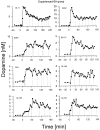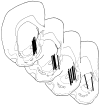Dopamine fluctuations in the nucleus accumbens during maintenance, extinction, and reinstatement of intravenous D-amphetamine self-administration
- PMID: 10234038
- PMCID: PMC6782708
- DOI: 10.1523/JNEUROSCI.19-10-04102.1999
Dopamine fluctuations in the nucleus accumbens during maintenance, extinction, and reinstatement of intravenous D-amphetamine self-administration
Abstract
Moment-to-moment fluctuations of nucleus accumbens dopamine (DA) were determined in rats self-administering or passively receiving "yoked" intravenous infusions of D-amphetamine. The initial lever presses of each session caused elevations in DA concentration, usually to an initial peak that was not maintained throughout the rest of the session. As the initial ("loading") injections were metabolized, DA levels dropped toward baseline but were sustained at elevated plateaus by subsequent lever pressing that was spaced throughout the remainder of the 3 hr sessions. During this period, DA levels fluctuated phasically, time-locked to the cycle of periodic lever pressing. Consistent with the known pharmacological actions and dynamics of amphetamine, peak DA elevations were seen approximately 10-15 min after each injection, and the mean DA level was at a low point in the phasic cycle at the time of each new lever press. During extinction periods when saline was substituted for amphetamine, DA levels dropped steadily toward baseline levels despite a dramatic increase in (now-unrewarded) lever pressing. Noncontingent injections during extinction reinstated lever-pressing behavior and increased nucleus accumbens DA concentrations. These data are consistent with the hypothesis that under the conditions of this experiment-during periods of amphetamine intoxication in well-trained animals-the timing of amphetamine self-administration comes primarily under the control of extracellular DA concentrations. The probability of lever pressing during the maintenance phase is highest when DA concentrations fall near a characteristic trigger point, a trigger point that is significantly elevated above baseline, and falls as DA concentrations fall below or increase above that trigger point.
Figures





Similar articles
-
Extracellular fluctuations of dopamine and glutamate in the nucleus accumbens core and shell associated with lever-pressing during cocaine self-administration, extinction, and yoked cocaine administration.Psychopharmacology (Berl). 2010 Aug;211(3):267-75. doi: 10.1007/s00213-010-1890-z. Epub 2010 Jun 12. Psychopharmacology (Berl). 2010. PMID: 20544343 Free PMC article.
-
Changes in dopamine efflux associated with extinction, CS-induced and d-amphetamine-induced reinstatement of drug-seeking behavior by rats.Behav Brain Res. 2001 May;120(2):147-58. doi: 10.1016/s0166-4328(00)00373-9. Behav Brain Res. 2001. PMID: 11182163
-
Drug- and behavior-associated changes in dopamine-related electrochemical signals during intravenous cocaine self-administration in rats.J Neurosci. 1994 Jul;14(7):4130-46. doi: 10.1523/JNEUROSCI.14-07-04130.1994. J Neurosci. 1994. PMID: 8027767 Free PMC article.
-
Nucleus accumbens dopamine-CCK interactions in psychostimulant reward and related behaviors.Neurosci Biobehav Rev. 1994 Summer;18(2):207-14. doi: 10.1016/0149-7634(94)90025-6. Neurosci Biobehav Rev. 1994. PMID: 7914685 Review.
-
Functional significance of mesolimbic dopamine.Neurosci Biobehav Rev. 1995 Winter;19(4):573-98. doi: 10.1016/0149-7634(95)00029-1. Neurosci Biobehav Rev. 1995. PMID: 8684717 Review.
Cited by
-
The effect of VMAT2 inhibitor GZ-793A on the reinstatement of methamphetamine-seeking in rats.Psychopharmacology (Berl). 2012 Nov;224(2):255-62. doi: 10.1007/s00213-012-2748-3. Epub 2012 May 26. Psychopharmacology (Berl). 2012. PMID: 22638813 Free PMC article.
-
Flavor-independent maintenance, extinction, and reinstatement of fat self-administration in mice.Biol Psychiatry. 2013 May 1;73(9):851-9. doi: 10.1016/j.biopsych.2013.02.028. Biol Psychiatry. 2013. PMID: 23587200 Free PMC article.
-
Variability of drug self-administration in rats.Psychopharmacology (Berl). 2003 Apr;167(1):9-19. doi: 10.1007/s00213-002-1366-x. Epub 2003 Mar 18. Psychopharmacology (Berl). 2003. PMID: 12644888
-
A role for conditioned ventral tegmental glutamate release in cocaine seeking.J Neurosci. 2007 Sep 26;27(39):10546-55. doi: 10.1523/JNEUROSCI.2967-07.2007. J Neurosci. 2007. PMID: 17898226 Free PMC article.
-
Neural vulnerability factors for obesity.Clin Psychol Rev. 2019 Mar;68:38-53. doi: 10.1016/j.cpr.2018.12.002. Epub 2018 Dec 19. Clin Psychol Rev. 2019. PMID: 30587407 Free PMC article. Review.
References
-
- Beninger RJ. The role of dopamine in locomotor activity and learning. Brain Res Rev. 1983;6:173–196. - PubMed
-
- Berger P, Elsworth JD, Reith MEA, Tanen D, Roth RH. Complex interaction of cocaine with the dopamine uptake carrier. Eur J Pharmacol. 1990;176:251–252. - PubMed
-
- Bozarth MA, Wise RA. Involvement of the ventral tegmental dopamine system in opioid and psychomotor stimulant reinforcement. In: Harris LS, editor. Problems of drug dependence, National Institute on Drug Abuse Res Monogr 67. US Government Printing Office; Washington, DC: 1986. pp. 190–196. - PubMed
-
- Dougherty J, Pickens R. Effects of phenobarbital and SKF 525A on cocaine self-administration in rats. In: Singh JM, Lal H, editors. Drug addiction, Vol 3, Neurobiology and influences on behavior. Symposia Specialists; Miami: 1974. pp. 135–143.
-
- Fibiger HC. Drugs and reinforcement mechanisms: a critical review of the catecholamine theory. Annu Rev Pharmacol Toxicol. 1978;18:37–56. - PubMed
Publication types
MeSH terms
Substances
Grants and funding
LinkOut - more resources
Full Text Sources
Research Materials
